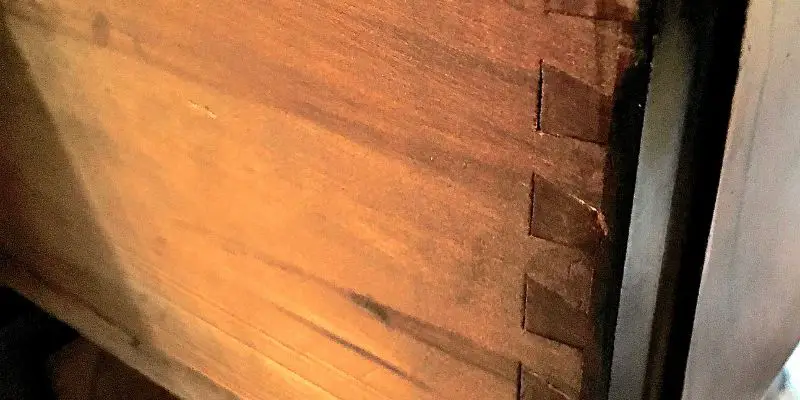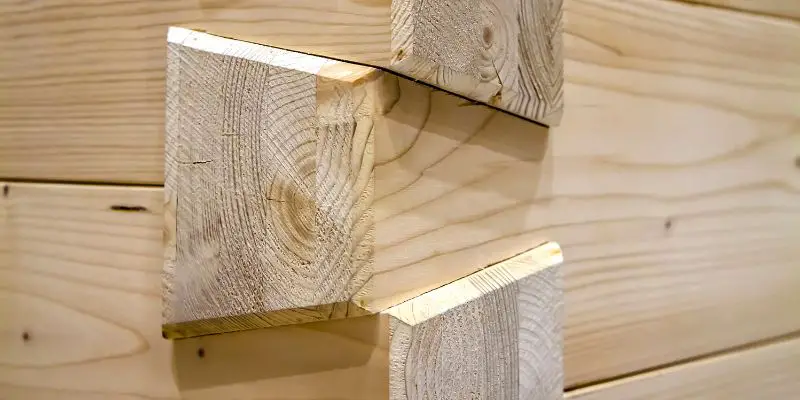Yes, it is possible to dovetail plywood. Dovetailing plywood involves using a specific woodworking technique to create interlocking joints for strong and secure connections in furniture and cabinetry, similar to dovetailing solid wood.
Dovetail joints provide stability and durability, and they can be made in both hardwood and plywood materials. By carefully cutting and fitting the plywood pieces together, you can create a visually appealing and robust finished project. Whether you are an experienced woodworker or a beginner, dovetailing plywood can add a touch of craftsmanship to your furniture creations.
We will explore the process of dovetailing plywood and provide some tips to help you achieve professional results.
What Is Dovetailing?
When it comes to woodworking, dovetailing is a technique that is highly regarded for its strength and durability. But what exactly is dovetailing? Dovetailing is a method of joining two pieces of wood together at a right angle, creating a joint that is not only aesthetically pleasing but also incredibly secure. In this blog post, we will delve deeper into the art of dovetailing and explore its benefits, particularly when it comes to working with plywood.
Understanding The Dovetail Joint
The dovetail joint is often described as a interlocking joint, consisting of a series of pins and tails that fit together tightly. This unique design makes it incredibly sturdy and resistant to forces that would typically be detrimental to other types of joints. The pins, which resemble the shape of a dove’s tail, extend from one piece of wood and fit into the tails on the other piece of wood, creating a strong bond that is difficult to break.
From an aesthetic standpoint, the dovetail joint is highly desirable. The interlocking pins and tails create an elegant and intricate pattern, showcasing the craftsmanship of the woodworker. Additionally, the precision required to create a dovetail joint demonstrates the skill and expertise of the craftsman.

Benefits Of Dovetailing In Woodworking
There are several reasons why dovetailing is favored in woodworking, including:
- Superior Strength: The tight interlocking design of the dovetail joint provides exceptional strength and durability. This is especially important when it comes to plywood, as the layers of veneer in plywood can be prone to separating under stress. Dovetailing helps to minimize the risk of plywood failure by creating a robust joint that can withstand heavy loads and movement.
- Resistance to Pulling Forces: Dovetail joints are renowned for their resistance to pulling forces. This means that the joint is less likely to come apart when subjected to stress or pressure, ensuring the longevity of the woodworking project.
- No Need for Additional Reinforcement: Unlike other types of joints that may require additional support or reinforcement, dovetailing creates a self-supporting joint that doesn’t rely on other materials. This can save time and effort in the woodworking process, as there is no need to add metal brackets or other reinforcements.
- Attractive and Professional Appearance: As mentioned earlier, the dovetail joint is not only incredibly strong but also visually appealing. The intricate pattern created by the interlocking pins and tails adds a touch of elegance to any woodworking project, making it a preferred choice for those who value both strength and aesthetics.
In conclusion, dovetailing is a highly effective technique for joining pieces of wood, particularly when it comes to working with plywood. The unique design of the dovetail joint provides exceptional strength, resistance to pulling forces, and an attractive appearance. Whether you’re a woodworking enthusiast or a professional craftsman, mastering the art of dovetailing can greatly enhance the quality and durability of your projects.
How To Dovetail Plywood
Dovetailing plywood is a technique that can add strength and visual appeal to your woodworking projects. While dovetailing is commonly used for solid wood joinery, it is possible to dovetail plywood as well. In this section, we will guide you through the process of dovetailing plywood, including tips on choosing the right plywood for the job, the tools and materials you’ll need, and a step-by-step guide to help you achieve clean and precise dovetail joints.
Choosing The Right Plywood For Dovetailing
When it comes to dovetailing plywood, selecting the right material is crucial. The quality and type of plywood can significantly affect the strength and durability of your joints. Here are some factors to consider when choosing plywood for dovetailing:
- Grade: Opt for a high-quality plywood with a solid veneer surface. The outer layers should be free from defects such as knots, voids, or patches. This will ensure smoother and more consistent dovetail cuts.
- Thickness: Thicker plywood tends to be more stable and less prone to flexing during the dovetailing process. Aim for a plywood thickness of at least 1/2 inch (12mm) for optimal results.
- Hardwood Plywood: Hardwood plywood, such as birch or oak, is often preferred for dovetailing due to its strength, stability, and aesthetic appeal. It provides a solid substrate for the dovetail joints and offers better resistance to wear and tear.
Tools And Materials Required
To dovetail plywood, you’ll need the following tools and materials:
- Dovetail Jig: A dovetail jig is an essential tool that helps guide your router or saw to create accurate dovetail cuts. Choose a jig that is compatible with the thickness of your plywood and the desired dovetail size.
- Router or Saw: A router with a dovetail bit or a dovetail saw is necessary to cut the dovetails. A router provides speed and precision, while a saw gives you more control over the cuts.
- Clamps: Clamps are used to secure the plywood and the dovetail jig in place, ensuring stability and accuracy during the cutting process.
- Safety Gear: Always prioritize safety when working with power tools. Wear safety glasses, hearing protection, and appropriate clothing.
Step-by-step Guide To Dovetailing Plywood
Follow these steps to dovetail plywood like a pro:
- Prepare the Plywood: Ensure that your plywood is clean, free from any dirt or debris, and accurately sized for your project.
- Set up the Dovetail Jig: Attach the jig to your workbench or tabletop, following the manufacturer’s instructions. Secure the plywood onto the jig, aligning it properly for a precise cut.
- Adjust the Router or Saw: Adjust the cutting depth and width of your router or saw to match the dovetail profile and the desired joint strength.
- Cut the Dovetails: Carefully guide your router or saw along the dovetail jig to create the dovetail cuts. Take your time and ensure steady movements for clean and accurate cuts.
- Repeat the Process: Repeat the dovetailing process for all the necessary joints in your project.
- Dry Fit and Assembly: Once the dovetails are cut, perform a dry fit to ensure that the joints fit together snugly. Make any necessary adjustments before applying glue and assembling the pieces.
- Glue and Clamp: Apply a thin layer of woodworking glue to the mating surfaces of the dovetails and assemble the joint. Secure it with clamps to ensure a tight bond and leave it to dry according to the adhesive manufacturer’s instructions.
- Clean and Finish: After the glue has dried, remove any excess adhesive and sand the plywood to achieve a smooth finish. Apply a suitable finish to protect and enhance the natural beauty of the wood.
By following these steps and using the right tools and materials, you can successfully dovetail plywood and create strong, durable, and visually appealing joinery for your woodworking projects. Remember to practice and take your time to perfect your dovetailing skills, and soon you’ll be able to master this technique with confidence. Happy woodworking!
Tips And Techniques For Successful Dovetailing
Dovetailing is a woodworking technique widely recognized for its strength and aesthetics. It involves interlocking two pieces of wood together using a series of angled cuts. While dovetail joints are commonly used with solid wood, it is also possible to dovetail plywood for various projects. In this section, we’ll explore some valuable tips and techniques to help you achieve precision and accuracy, handle and maintain your tools properly, avoid common mistakes, and enhance your dovetailing skills.
Precision And Accuracy
When it comes to dovetailing, precision and accuracy are paramount. A snug fit is essential for creating a strong joint, so it’s crucial to make accurate measurements and cuts. Here are some tips to ensure precision and accuracy:
- Use high-quality measuring tools, like a precision caliper, to measure and mark your cuts precisely.
- Take the time to lay out your dovetails carefully and accurately on the plywood.
- Invest in a high-quality dovetail saw with a sharp blade to ensure clean and precise cuts.
- Practice makes perfect! Start with simpler dovetailing projects before moving on to more complex ones.
Proper Tool Handling And Maintenance
Handling and maintaining your tools properly is crucial for successful dovetailing. Keeping your tools in good shape ensures clean cuts and prolongs their lifespan. Follow these tips for proper tool handling and maintenance:
- Regularly sharpen your dovetail saw with a fine-tooth file to maintain its cutting efficiency.
- Periodically wax the saw blade to reduce friction and improve cutting performance.
- Keep your chisels sharp and clean to achieve clean and precise results.
- Invest in a sturdy workbench or vice to secure your plywood during the dovetailing process.
Common Mistakes To Avoid
While learning to dovetail, it’s easy to fall into common mistakes that can affect the overall quality of your joints. Be aware of these common mistakes and avoid them to improve your dovetailing skills:
- Avoid cutting your dovetails too shallow, as this can result in weak joints.
- Ensure your cuts are straight and parallel to avoid gaps or misalignment.
- Don’t rush the process. Take your time and double-check your measurements, markings, and cuts.
- Avoid over-tightening your joints, as this can cause the plywood to split or break.
Enhancing Dovetailing Skills
To enhance your dovetailing skills and create stunning joints, consider the following tips:
- Join woodworking forums or communities to learn from experienced woodworkers and gain valuable insights.
- Experiment with different types of dovetail joints, such as through dovetails or half-blind dovetails, to expand your repertoire.
- Practice hand-cut dovetails regularly to improve your technique and precision.
- Consider using jigs or specialized dovetailing aids to assist with accuracy, especially for complex projects.

Frequently Asked Questions On Can You Dovetail Plywood
Can You Do Dovetail Joints With Plywood?
Yes, you can do dovetail joints with plywood. They are commonly used in joinery to create strong, interlocking connections. With the right tools and techniques, you can achieve precise and secure dovetail joints in plywood.
What Are The Cons Of Dovetail?
One drawback of dovetail joints is that they require more time and precision to create compared to other joint types. Additionally, they can be challenging for beginners and may not be suitable for certain projects.
Can You Dovetail Baltic Birch?
Yes, you can dovetail Baltic birch. It is a strong and durable type of plywood often used for woodworking projects. Dovetailing is a technique for joining pieces of wood together, and Baltic birch can be successfully dovetailed using appropriate tools and techniques.
Are Dovetail Joints Worth It?
Yes, dovetail joints are worth it. They provide sturdy and attractive connections between wood pieces. They have a strong grip and prevent pieces from coming apart. Dovetail joints add durability and craftsmanship to furniture, making them an excellent choice for quality woodworking projects.
Conclusion
To summarize, dovetailing plywood is a technique that offers strength and durability to joinery projects. By creating interlocking joints, it ensures stability and prevents separation over time. Whether you’re working on furniture, cabinets, or decorative pieces, dovetailing is a valuable skill to possess.
Remember to choose the right tools, follow proper techniques, and practice to achieve precise and seamless results. So why wait? Start exploring the world of dovetailing and enhance your woodworking skills today!


